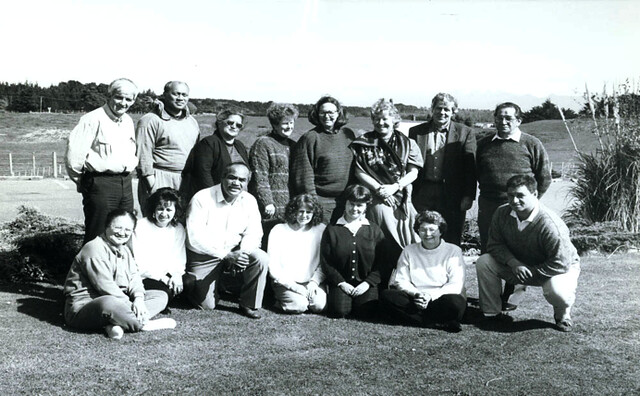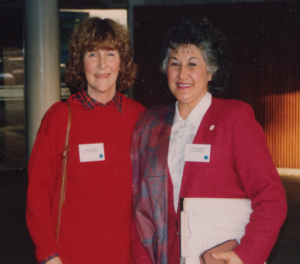Reflections on the third decade by Mary Nash
On the international scene, the IFSW was declared a “Peace Messenger” by the UN Secretary General in 1985. The 1980’s were particularly active years in human rights and social justice with active teams to the UN in New York, Geneva and Vienna. First in a series of “IFSW Policy Papers” published in 1980 (Human Rights) Human Rights Commission established in 1988, working for social workers, social welfare workers and social work students whose human rights have been challenged, promoting education of social work and human rights globally and writing publications as the “UN Training Manual on Social Work and Human Rights” (1992) and Social Work and the Rights of the Child (2002).
In Aotearoa New Zealand, a Labour Government was elected in 1984, and on reaching power, was presented by Treasury officials with a financial crisis and a plan for dealing with it in which the Treasury recommended a radical review of the welfare approach to social policy. The new ideological approach placed responsibility for welfare squarely back with the family and the local community, and was fuelled by the state’s need to respond to economic difficulties. The economic imperative to cut government costs through devolution and decentralisation was aligned with the grass roots determination to gain more autonomy. In the late 1980s, the Department of Social Welfare underwent profound organisational changes in accordance with a new set of welfare principles (Barretta-Herman, 1994).
In this decade, governments, first Labour and later National, called for reports and reviews to provide them with information. In the education sector, the Picot Report, Tomorrow’s Schools (1988) recommended devolution and decentralisation of the school system. In the health sector, Area Health Boards had already been legislated for and were later established in the name of devolution, despite the recommendations of the Gibbs’ Report Unshackling the Hospitals (1987), which advocated introducing the funder-provider split. Ahead of its time, the report was simply put on hold and later revisited by a National Government which replaced Area Health Boards by a system of Regional Health Authorities and Crown Health Enterprises. The April Report of the Royal Commission on Social Policy (1988), chaired by Professor Ian Shirley, was the result of widespread consultation with the people of New Zealand on the kind of social policies they wanted the Government to put in place. It depicted a high level of support in the country for giving priority to collective social wellbeing over individualised economic wellbeing. The title of this report, Towards a Fair and Just Society, signalled its philosophical approach. (Nash, 1998, p337)
The Report of the Women Against Racism Action Group (WARAG) (1985) was produced by nine feminist women in the Department of Social Welfare who “shared concern about racism in Aotearoa and in our Department” (WARAG, 1985: 1). The Report uncovered racism and sexism in the Department of Social Welfare and contained several recommendations deemed radical at the time, and eventually its ideas gained widespread support.
Two themes which occupied the Association in this decade, were the development and articulation of a Maori perspective in social work (and the resulting challenge to what has been an essentially Pakeha organisation) and second the need to establish some mechanism for external professional accountability for social workers in New Zealand. (Beddoe and Randall, 1994. pp21) These, and other issues including feminism, caused much soul-searching and bitterness.
In 1986 Puao-te-ata-tu, the report of the Ministerial Advisory Committee on a Māori Perspective for the Department of Social Welfare was published. This report provided a Māori perspective on ‘aspects of the Social Welfare Department which are detrimental to the Māori people’ (Puao-te-ata-tu, 1986:6). John Rangihau chaired the advisory committee. He was a qualified social worker, an elder of his iwi and much respected. The report drew attention to racism in many aspects of the working of the Department, and pointed out that
At the heart of the issue is a profound misunderstanding or ignorance of the place of the child in Māori society and its relationship with whanau, hapu and iwi. ( p. 7).
This report was succinct, well-researched and presented a clear, uncompromising picture of problems within the Department of Social Welfare and their remedies.
The first recommendation was that the Government endorse the following policy objective:
To attack all forms of cultural racism in New Zealand that result in the values and lifestyle of the dominant group being regarded as superior to those of other groups, especially Maori, by;
(a) providing leadership and programmes which help develop a society in which the values of all groups are of cultural importance; and
(b) Incorporating the values, cultures and beliefs of the Māori people in all policies developed for the future of New Zealand (Puao-te-ata-tu, 1986, p.9).
This was radical and painful for many of the pakeha social workers, whether sympathetic to Māori development or not. There are some who question whether Puao-te-ata-tu has been forgotten but it remains a landmark, a reference point still used by policy analysts and social worker educators today.
The 1986 Biennial Conference was held at Turangawaewae Marae, Ngaruawahia, in August. Its theme was Social Work in a changing world. The opening speaker was Mr Hirsh, the Race Relations Conciliator. The first remit, that the Association be wound up, was opposed, with Merv Hancock strongly encouraging its defeat. The future structure of the Association was then discussed and a proposal that there be a Māori and Pakeha (later, Manuhiri) Caucus was eventually carried. Sarah Fraser became President of the Pakeha Caucus, and Rahera Ohia became President of the Māori Caucus. Both were graduates of the BSW programme at Massey University and knew each other well, which was almost certainly a stabilising factor. This dramatic and volatile situation for the NZASW reflected the turmoil over race relations in the country in general and Maori challenges to the Department of Social Welfare and its social work staff in particular. (Nash 1989. p270)
During the 1988 Annual Conference, the NZASW, in order to combat waning membership, set up the structure and processes which would enable membership of the Association to be based on the demonstration of competent social work practice, using competency assessment based on its own practice standards and administered by a Board of Competency composed of members of the Association. In 1989, an interim Board of Competency was appointed to prepare ‘Competent Social Work Practice, a handbook for members of NZASW’ and this was duly published in 1990. Members of the interim Board of Competency were: Maurice McGregor of Christchurch (Chairperson); Louise Nicoll of Dunedin, June Kendrick of Auckland, Ken Daniels of Christchurch, Raylee Kane of Christchurch and Lynne Briggs of Christchurch, President of NZASW. This proved an innovative and successful initiative, strengthening the Association.
In 1989, the Children, Young Persons and Their Families Act (1989) represented a paradigm shift in thinking away from the monocultural approach embedded in the 1974 Children and Young Persons Act towards the biculturalism advocated in Puao-te-ata-tu, with its focus on whanau and the recognition of the mutuality of interests of whanau and child (Cockburn, 1994: 86).
When the NZSWTC was disbanded, it was replaced with the New Zealand Council for Education and Training in the Social Services (NZCETSS). NZCETSS was composed of equal numbers of Tangata Whenua and Tauiwi, led by people with strong views about the social justice role in social and community development work. They managed to function together with respect for each other’s cultural differences and protocols around representation and consultation (Nash, 1998). NZCETSS developed sound standards for bi-cultural social service practice which were widely accepted.

By the end of this decade, the sense of altruism and social justice that is an intrinsic part of social work was coming under pressure from the rising supremacy of economic policy. NZCETSS was transforming itself into an Industry Training organisation and the funder/provider split was beginning to change the organisational context for social work.

References
Barretta-Herman, A. (1994). Welfare State to Welfare Society. New York and London: Garland Publishing, Inc.
Beddoe, L., and Randal, H. (1994). The New Zealand Association of Social Workers. In R. Munford and M. Nash (Eds.), Social Work in Action. Palmerston North: Dunmore Press.
Benton, R., Benton, N., et al. (1991). Kahukura. The Possible Dream. Wellington: NZCETSS.
Cockburn, G. (1994). The Children, Young Persons and Their Families Act, 1989: Past, present and future. In R. Munford and M. Nash (Eds.), Social Work in Action. Palmerston North: Dunmore Press.
Department of Social Welfare (1985). Review of the Department of Social Welfare: Tamaki-Makau-Rau, Auckland (revised), (WARAG). Wellington: Department of Social Welfare.
Department of Social Welfare (1986). Report on Women and Social Welfare. Women Against Racism Advisory Group. Wellington: Department of Social Welfare.
Hancock, M.W. (1985). Ministerial Review Committee Report on the Social Work Training Council. Prepared at the request of the Minister of Social Welfare.
Ministerial Advisory Committee (1986). Puao-te ata tu, Report of the Ministerial Advisory Committee. Wellington: Department of Social Welfare.
Nash, M. (1998). People, Policies and practice: A history of social work education in Aotearoa/New Zealand. 1949-95. Massey University, Palmerston North, New Zealand. Unpublished PhD Thesis.
Royal Commission on Social Policy. (1988). The April Report. Wellington: Government Printer.
